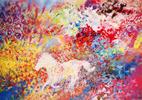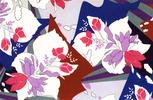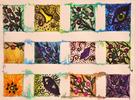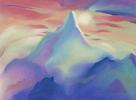|
|
 |
Love Without Gravity (first collection)
In my art, "top" is usually where I decide "top" is. There is often no sky, no trees reaching upwards, no roses blooming from a garden's bed, no people or animals standing where they normally stand, somewhere on the Earth's surface with the ground firmly beneath them -- and held to that surface by the force of gravity. And so, for many years now, I have used the phrase "Love Without Gravity" to describe my art because it has been my intention from the beginning (1968) to uplift people with creations that are not dependent upon the usual appearances of our world, its people, objects and places. (Please click on the "Love Without Gravity" link in the menu to read the complete story.)
|
 |
Love Without Gravity (second collection)
Question: What does art have to do with the Laws of Gravity?
Answer: Nothing.
|
 |
The Natural World (more or less)
Although the major direction and emphasis of my art has always been towards abstraction, now and then I like to paint something more or less recognizable: a stand of trees, flowers, fields, clouds, mountains and gardens. One painting from 1995 even included a "magic cottage" that I dreamed would one day be my studio! But even here, in such paintings of the "natural world", the scenes and colors are always drawn from my imagination.
|
 |
Maximum color, minimum form
In these paintings, I have focused mainly on my love of color as color, independent of carefully defined forms. I have used just enough form to slightly organize the color and elevate the whole into a coherent work of art that communicates ideas and emotions to the viewer.
|
 |
A World Without Color: Black & White & Grey
In 1972 I began experimenting with my own "winter palette": blacks, whites and greys. By 1974 I had completed a painting called "The White Place", the first picture in this new (for me) genre that I was entirely happy with. But it was during those first few months of experimentation in 1972 that I learned a simple lesson: The visual power and emotional impact of an artist's communication does not have to depend upon the use of color.
|
 |
Designs for Textiles: Apparel & Home Furnishings
I had been a professional painter for 25 years, when, in December of 1993, I packed my artist's gear, locked the door of my condo overlooking Clearwater's Intercoastal Waterway and moved 4000 miles across the Atlantic to East Grinstead, an old (1086 A.D.) English town in the rolling hills of county Sussex. I rented the three story house at 4 Morton Road, set up a studio on the top floor and learned the techniques and skills of the commercial textile designer -- creating the repeating patterns that decorate the surface of woven materials.
|
 |
The Art of Teaching Art
I am at home in many places: Boston, Cambridge, Cape Cod, Hollywood, Switzerland, Southern England, and the White Mountains of New Hampshire to name some of the important ones. But of all these, perhaps the most important is the truly excellent private school, Clearwater Academy International, where I spend my days working as an academic tutor to the youngest children, those from kindergarten through the 3rd grade, helping them with their difficulties in math, writing, reading, spelling, phonics and such. For giving them my professional help (and lots of love and interest in their lives), they sometimes "reward" me with their drawings, which hang everywhere in my little office on the first floor. While they are creating their art, I think to myself "I am in The Children's Studio " -- and that has become my private name for my room. Daily, I am struck by the intensity of life and beauty that dwells within these young people.
I also have the opportunity (as in the summers of 2009 and 2010) to teach a variety of art workshops (Japanese Design, Watercolor, Textile Design, etc.) to the older children. Despite the fact that their artwork has to be created rather quickly during these short, summer classes, the quality of the student's work is exceptionally high.
|
 |
Pictures for Children
Most of my "Pictures for Children" were created during the spring and summer of 1994 when I lived in East Grinstead, about an hour south of London. I was busy freelancing as a textile designer when the opportunity arose to present my work to an established Parisian designer of children's clothing. I'm afraid the actual presentation did not work out well, but making the pictures was a wonderful experience. I was left with a lot of simple but delightful pictures of land and sea animals (and even a few dancing, flying people) that have been making children happy ever since.
|
 |
Designs from the Three Americas: Inca/ Aztec/ Maya/Native American
While living in Cambridge, Massachusetts between 1968 and 1971, I created a long series of drawings and paintings using a wide variety of media: pencils, pen & ink, markers, acrylics, watercolors, oil pastels and cut paper. At that time, I did not consciously reflect on what what I was creating; I was simply and spontaneously expressing what was naturally in me.Thus I was surprised when a number of people noted a similarity between some of the motifs, colors and styles of my work to the original art forms of the native peoples of North, South and Central America. At first, I was mystified. Then, becoming curious, I did a little research to see if it was true -- and it was!
|
 |
Works-In-a-Series, Diptychs, Triptychs, Murals
My "Works-In-A-Series" are a number of paintings created around the same central motif. Typically, the motif evolves and develops over a lengthy span of time, such as years or even decades.
A "diptych" is two intimately-related-but-independent works meant to be displayed and viewed as one work. And, of course, a "triptych" consists of three such works, instead of two.
|
|
|